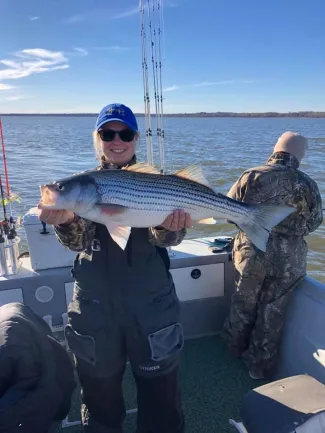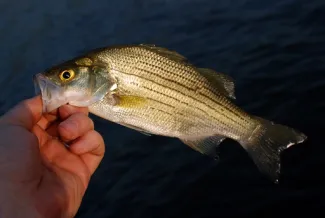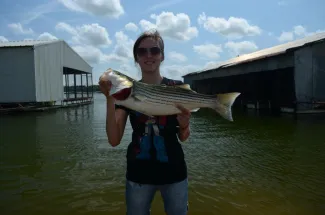Our great state overflows with outdoor opportunities for anyone to enjoy, especially anglers. Oklahoma’s diverse landscape is enriched with more than 55,000 miles of shoreline and more than 167,000 miles of rivers and streams, providing nearly endless angling opportunities. This natural bounty would not be possible without flowing water however. While seemingly simple, flowing water is critical for many of the most sought after fish species by anglers in Oklahoma. White bass and striped bass for example have adapted well to life in a reservoir, but they still require adequate seasonal flows of water in streams to produce and maintain healthy populations.
White bass are famed for their annual spawning runs, during which anglers often catch fish until their arms wear out. This annual migration draws hopeful anglers to the banks of tributaries and feeder creeks at most reservoirs in late March and April when water temperatures warm to the 50-60 degree range. In search of shallow rock and shoal habitat to spawn, white bass migrate from their reservoir waters into tributary streams where flowing water is needed to complete their reproductive cycle. Sticky fertilized eggs remain attached to shallow rocks while dissolved oxygen in flowing water helps the eggs develop into tiny fry. The fry drift back into the reservoir where they mature into adults and begin their lives.
In a similar fashion, striped bass (a native saltwater species transplanted into fresh water by biologists) also utilize flowing streams to complete their reproductive cycle. Oklahoma is proud to claim a handful of the very limited number of freshwater striped bass populations that can successfully reproduce in inland waters. Similar to white bass, adult stripers leave their reservoir homes to migrate up flowing streams when sufficient stream inflows reach 60-70 degrees. Unlike the white bass, striped bass eggs are buoyant and utilize the flowing water to develop and hatch as they float many miles back to the reservoir. Research conducted by ODWC from 2001-2004 identified numerous striped bass spawning locations between 35 and 100 miles above Lake Texoma in the Washita and Red rivers. While floating towards the reservoir following a spawning event, the striped bass eggs develop and hatch in the moving waters of the stream.
Adequate amounts of flowing water is the most critical ingredient needed to produce abundant year classes of white bass and striped bass populations in our state. The stream flows initiate the spawning cues for adult fish, provide a healthy environment for spawning and egg hatching, and then transport developing eggs and young fry back to the food rich environment of the reservoir that they need to grow into the adult fish Oklahoma anglers love to pursue. Maintaining and protecting seasonal flows is a vital conservation measure to ensure healthy populations of white bass and striped bass in our waters.

White Bass Spawning Run Fishing
There are many locations around Oklahoma to experience the fast-paced action of catching white bass during the spring spawning run. Most reservoirs with tributary streams feeding the lake will provide the habitat needed by white bass to spawn. Anglers should target locations on the stream where natural barriers such as shoals or rock/gravel bars concentrate fish by restricting upstream movement to some degree. Adult fish will congregate below these natural pinch points and either spawn there, or rest and feed to continue their upstream journey to spawning grounds. Some of the best fishing is found at Horseshoe Bend in the Illinois River on the upper end of Lake Tenkiller, the North Canadian River above Canton Lake, the Little Beaver and Arkansas rivers above Kaw Lake, the Spring River above Grand Lake, and the Little and Big Beaver rivers above Waurika Lake.

Striped Bass Spawning Run Fishing
Access to the Washita and Red rivers above Lake Texoma is limited and remote, so most anglers prefer to wait for the striped bass to return to the reservoir rather than fish for them during the spawning run. However, migrating and spawning fish can be accessed at several locations throughout the Arkansas River system where adults congregate below reservoir dams such as the Kaw and Keystone tailwaters on the Arkansas River, below Tenkiller dam on the Lower Illinois River, or below Eufaula dam on the Canadian River. The low-water dam (Zink dam) in Tulsa offers excellent urban access to large spawning striped bass in April and May. Webbers Falls and R.S Kerr dams further downstream on the Arkansas River are also good places to target migrating striped bass. ODWC researchers collected and tagged over 800 striped bass up to 56 pounds on this Arkansas River system during project work between 2010 and 2012. Five stripers larger than the current state record of 48.5 pounds were tagged and released in the locations mentioned above.
